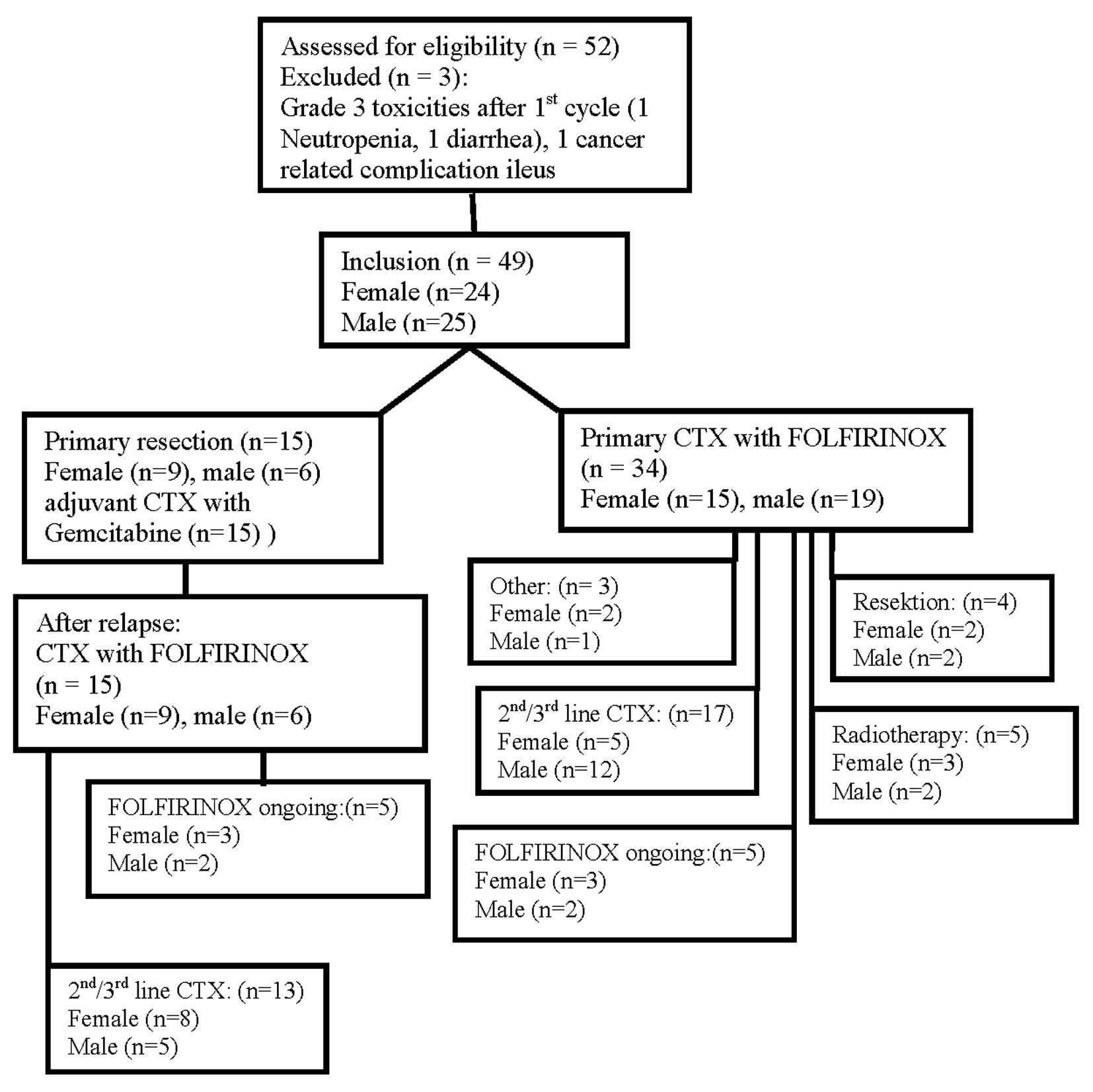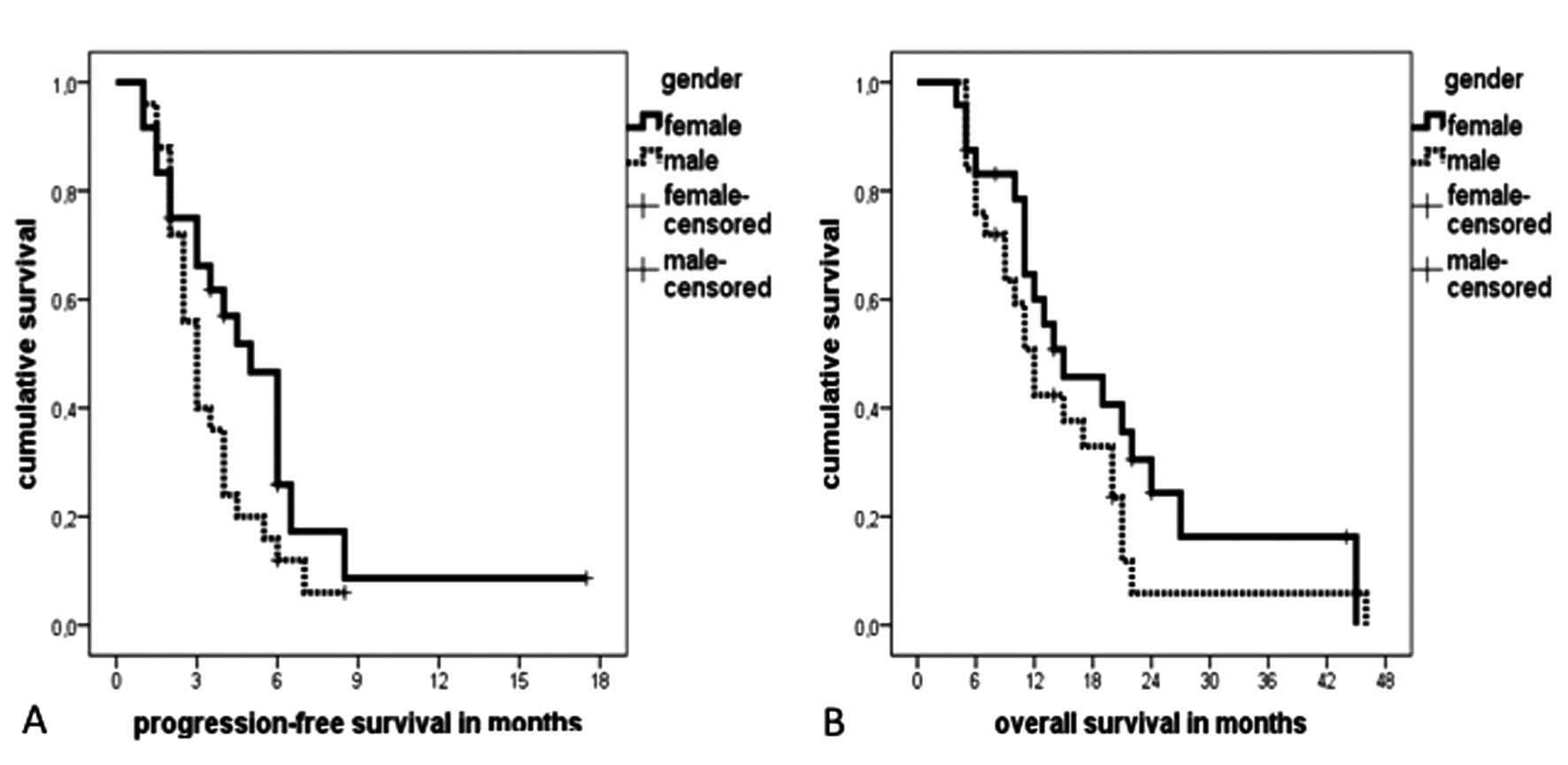|
1.
|
Siegel R, Naishadham D and Jemal A: Cancer
statistics, 2012. CA Cancer J Clin. 62:10–29. 2012. View Article : Google Scholar
|
|
2.
|
Lefebvre AC, Maurel J, Boutreux S, et al:
Pancreatic cancer: incidence, treatment and survival trends - 1175
cases in Calvados (France) from 1978 to 2002. Gastroenterol Clin
Biol. 33:1045–1051. 2009. View Article : Google Scholar : PubMed/NCBI
|
|
3.
|
Burris HA III, Moore MJ, Andersen J, et
al: Improvements in survival and clinical benefit with gemcitabine
as first-line therapy for patients with advanced pancreas cancer: a
randomized trial. J Clin Oncol. 15:2403–2413. 1997.PubMed/NCBI
|
|
4.
|
Di Marco M, Di Cicilia R, Macchini M, et
al: Metastatic pancreatic cancer: is gemcitabine still the best
standard treatment? (Review). Oncol Rep. 23:1183–1192.
2010.PubMed/NCBI
|
|
5.
|
Cunningham D, Chau I, Stocken DD, et al:
Phase III randomized comparison of gemcitabine versus gemcitabine
plus capecitabine in patients with advanced pancreatic cancer. J
Clin Oncol. 27:5513–5518. 2009. View Article : Google Scholar : PubMed/NCBI
|
|
6.
|
Moore MJ, Goldstein D, Hamm J, et al:
Erlotinib plus gemcitabine compared with gemcitabine alone in
patients with advanced pancreatic cancer: a phase III trial of the
National Cancer Institute of Canada Clinical Trials Group. J Clin
Oncol. 25:1960–1966. 2007. View Article : Google Scholar
|
|
7.
|
Conroy T, Paillot B, Francois E, et al:
Irinotecan plus oxaliplatin and leucovorin-modulated fluorouracil
in advanced pancreatic cancer - a Groupe Tumeurs Digestives of the
Federation Nationale des Centres de Lutte Contre le Cancer study. J
Clin Oncol. 23:1228–1236. 2005. View Article : Google Scholar
|
|
8.
|
Conroy T, Desseigne F, Ychou M, et al:
FOLFIRINOX versus gemcitabine for metastatic pancreatic cancer. N
Engl J Med. 364:1817–1825. 2011. View Article : Google Scholar : PubMed/NCBI
|
|
9.
|
Therasse P, Arbuck SG, Eisenhauer EA, et
al: New guidelines to evaluate the response to treatment in solid
tumors. European Organization for Research and Treatment of Cancer,
National Cancer Institute of the United States, National Cancer
Institute of Canada. J Natl Cancer Inst. 92:205–216. 2000.
View Article : Google Scholar
|
|
10.
|
Dowsett M, Nielsen TO, A’Hern R, et al:
Assessment of Ki67 in breast cancer: recommendations from the
International Ki67 in Breast Cancer working group. J Natl Cancer
Inst. 103:1656–1664. 2011. View Article : Google Scholar : PubMed/NCBI
|
|
11.
|
Sant M, Allemani C, Santaquilani M, Knijn
A, Marchesi F and Capocaccia R; EUROCARE-4: Survival of cancer
patients diagnosed in 1995–1999 Results and commentary. Eur J
Cancer. 45:931–991. 2009.
|
|
12.
|
Gunturu KS, Yao X, Cong X, et al:
FOLFIRINOX for locally advanced and metastatic pancreatic cancer:
single institution retrospective review of efficacy and toxicity.
Med Oncol. 30:3612013. View Article : Google Scholar : PubMed/NCBI
|
|
13.
|
Ballehaninna UK and Chamberlain RS: The
clinical utility of serum CA 19-9 in the diagnosis, prognosis and
management of pancreatic adenocarcinoma: An evidence based
appraisal. J Gastrointest Oncol. 3:105–119. 2012.PubMed/NCBI
|
|
14.
|
Micke O, Bruns F, Kurowski R, et al:
Predictive value of carbohydrate antigen 19-9 in pancreatic cancer
treated with radiochemotherapy. Int J Radiat Oncol Biol Phys.
57:90–97. 2003. View Article : Google Scholar : PubMed/NCBI
|
|
15.
|
Humphris JL, Chang DK, Johns AL, et al:
The prognostic and predictive value of serum CA19.9 in pancreatic
cancer. Ann Oncol. 23:1713–1722. 2012. View Article : Google Scholar : PubMed/NCBI
|
|
16.
|
Fasching PA, Heusinger K, Haeberle L, et
al: Ki67, chemo-therapy response, and prognosis in breast cancer
patients receiving neoadjuvant treatment. BMC Cancer. 11:4862011.
View Article : Google Scholar : PubMed/NCBI
|
|
17.
|
Zhang GC, Qian XK, Guo ZB, et al:
Pre-treatment hormonal receptor status and Ki67 index predict
pathologic complete response to neoadjuvant trastuzumab/taxanes but
not disease-free survival in HER2-positive breast cancer patients.
Med Oncol. 29:3222–3231. 2012. View Article : Google Scholar
|
|
18.
|
Carlomagno C, Pepe S, D’Armiento FP, et
al: Predictive factors of complete response to neoadjuvant
chemoradiotherapy in patients with rectal cancer. Oncology.
78:369–375. 2010. View Article : Google Scholar : PubMed/NCBI
|
|
19.
|
Ressiot E, Dahan L, Liprandi A, et al:
Predictive factors of the response to chemoradiotherapy in
esophageal cancer. Gastroenterol Clin Biol. 32:567–577. 2008.
View Article : Google Scholar : PubMed/NCBI
|
|
20.
|
Soussi T: p53 alterations in human cancer:
more questions than answers. Oncogene. 26:2145–2156. 2007.
View Article : Google Scholar : PubMed/NCBI
|
|
21.
|
Sax JK and El-Deiry WS: p53 downstream
targets and chemo-sensitivity. Cell Death Differ. 10:413–417. 2003.
View Article : Google Scholar
|
|
22.
|
Bertheau P, Espie M, Turpin E, et al: TP53
status and response to chemotherapy in breast cancer. Pathobiology.
75:132–139. 2008. View Article : Google Scholar : PubMed/NCBI
|
|
23.
|
Bataille F, Rummele P, Dietmaier W, et al:
Alterations in p53 predict response to preoperative high dose
chemotherapy in patients with gastric cancer. Mol Pathol.
56:286–292. 2003. View Article : Google Scholar : PubMed/NCBI
|











